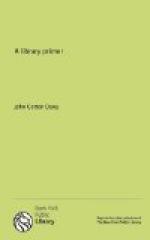Classifying books
The smallest public library should be classified and cataloged. This will make its resources more easily available, and will prevent the confusion and waste of labor which are sure to come if systematic treatment of the books is deferred. Get the best advice obtainable; consider the library’s field and its possibilities of growth, and let the first work on the books be such as will never need to be done over.
To classify books is to place them in groups, each group including, as nearly as may be, all the books treating of a given subject, for instance, geology; or all the books, on whatever subject, cast in a particular form—for instance, poetry; or all the books having to do with a particular period of time—for instance, the middle ages. Few books are devoted exclusively to one subject and belong absolutely in any one class. The classification of books must be a continual compromise. Its purpose is not accurately to classify all printed things, this can’t be done; but simply to make certain sources of information—books—more available. Any classification, if it gets the books on a given subject side by side, and those on allied subjects near one another, is a good one.
Books may be classified into groups in a catalog or list, yet themselves stand without order on the shelves. For convenience in getting for anyone all the books on a given subject, and especially for the help of those who are permitted to visit the shelves, all books should stand in their appropriate classes. Each book, therefore, should bear a mark which will tell in what class it belongs; distinguish it from all other books in that class; show where it stands on the shelves among its fellows of the same class; and indicate which one it is of several possible copies of the same book. This mark can be used to designate the book in all records of it, instead of the larger entry of its author and title.
There are two classification systems worthy of consideration, the Dewey, or decimal, and the Cutter, or expansive. They are outlined in the following chapters. Don’t try to devise a system of your own.
Having decided on your system of classification, begin to classify. This is one of the many things which can only be learned by doing. Give fiction no class number, but an author number or “book-mark” only, as explained in a later chapter. Give all biography a single letter as its class number, and follow this by the author number.
Distinguish all juvenile books, whether fiction or other, by writing before their numbers some distinguishing symbol.
Take up first, in classification proper, the subjects of history and travel, which will be found comparatively easy.
It is easier to classify 25 or 50 books at a time in any given class than it is to classify them singly as you come to them in the midst of books of other classes. Consequently, group your books roughly into classes before you begin work on them.




